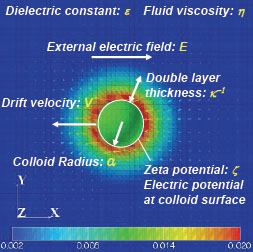

Electrophoresis of small particles are of great importance not only in pure science, but also in several engineering fields. Analytical theories have been well established for dilute dispersions, but not for dense dispersions because of the difficulties ascribable to the hydrodynamic and electrostatic many-body effects. Therefore electrophoresis of dense colloidal dispersions has been an important unsolved problem for more than a decade. Computer simulation is a promising tool to solve this problem, however, simulations performed so far for electrophoresis of charged colloids remain either for small number of particles with some quantitative reliability or for many particles with less reliability. The main difficulty is how to resolve the hydrodynamic and electrostatic interactions acting on colloidal particles consistently within a reasonable computation time.

In this study, we examined the volume fraction dependency of the electrophoretic mobility using a unique simulation scheme, called the smoothed profile (SP) method, and found that it clearly deviates from the mean field type theories based on the cell model when overlapping of the electric double layer becomes important. Here, the many body electro-hydrodynamic interactions are fully taken into account through the diffuse interface between colloids and fluids. Then the time evolutions of colloidal particles, ions, and host fluids are computed simultaneously by solving the Newton's, the Navier--Stokes, and the advection-diffusion equations. The present study is the first successful attempt which provides quantitative data necessary to examine the reliability of several analytic models proposed for electrophoresis of dense colloidal dispersions.